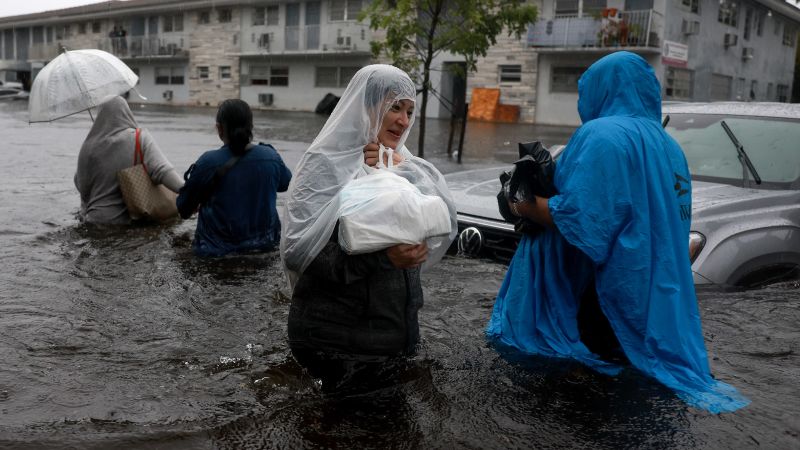South Florida flooding swamps streets and homes. The threat still isn’t over

CNN
—
Heavy rainfall could swamp South Florida for a third day in a row on Thursday, threatening more destructive flooding after Wednesday’s storms transformed roads into canals and seeped into homes – and more is yet to come later this week.
Florida Gov. Ron DeSantis has declared an emergency for Broward, Collier, Lee, Miami-Dade and Sarasota counties after dangerous flooding immobilized the operations of critical infrastructure on Wednesday, including major interstates, roadways, schools and airports.
Flood warnings are in place for cities including Fort Lauderdale, Miami and Naples until Thursday morning, where between 4 and 13 inches of rainfall fell across the region Wednesday. Additional rainfall up to 2 inches possible in the area.
Flood watches are in effect through Friday evening across Southern Florida, where more rounds of heavy rainfall are expected.
Severe flooding in Hallandale Beach submerged cars up to their windshields in some places, forcing some drivers to abandon their stalled-out vehicles and wade to safety.
A family lost their young son during the storm Wednesday, but were later reunited with the help of police who found the child, Hallandale Beach officials said.
Resident Kait Madrigal spent five hours stuck in her car Wednesday after it became suddenly surrounded by floodwaters on her way to work near Hollywood, Florida, she told CNN. She was able to park on the sidewalk to get to higher ground but began to panic as the water rose and cars began to stall out around her.
“If I was to open my car door, I would’ve just had a ton of water rushing in. I would’ve been out of luck big time,” the 25-year-old said.
After hours of unrelenting rain, Madrigal waded through the water and was able to find a possible exit route. Fearing she may become trapped all night, she drove out and was able to get home safely, she said.
Several local officials have warned against trying to drive through murky floodwaters and are urging storm-weary South Floridians to stay home. Most flood-related drownings occur when cars unknowingly drive into deep water, the Floriday Department of Highway Safety said.

Fort Lauderdale, where the mayor declared a local state of emergency, received more than a month’s worth of rain Wednesday with 9.58 inches – eclipsing its average June rainfall of 9.55 inches.
Miami International Airport and Fort Lauderdale-Hollywood International Airport led the nation with the most flights canceled or delayed Wednesday, with more than 1,200 disruptions. The air travel woes are only expected to continue through the end of the workweek.
In Broward County, the severe storms prompted school officials to postpone the demolition of the Marjory Stoneman Douglas High School building where a gunman killed 17 people in 2018.
Many South Florida residents had only just finished repairing their homes after catastrophic flooding in April 2023, only to find water lapping at their doorsteps Wednesday.
Anna Rysedorph, a resident of the Broward County neighborhood of Edgewood, prepared for the worst as water circled her ankles in her home.
“I put the dogs in, I’m all packed up. I pretty much got everything in bins and we’re ready to go,” Edgewood resident Anna Rysedorph told CNN affiliate WSVN Wednesday. “My husband’s like ‘Don’t panic, don’t panic,’ but you know, I’m not gonna be caught unprepared.”
Considerable flooding is possible across the southern Florida Peninsula on Thursday and Friday as a broad swath of storms pass over the state.
Flood watches are in effect for over 8 million people across the region through Thursday night, with some watches across the greater Miami area lasting into Friday.
Parts of the state are likely to see double-digit rainfall totals by the time all is said and done. Totals of 10 inches or more are most likely across the southwestern Gulf Coast of the state, from Sarasota to Everglades National Park.
The flood risk will grow through the week as storms unleash torrential downpours over the same area each day, soaking the soil and overwhelming waterways.
While the state is no stranger to drenching rain, heavy rain events are getting even heavier as the world warms due to fossil fuel pollution. The daily downpours are also being fueled by a firehose of tropical moisture from parts of the Caribbean funneling straight into South Florida along a front draped over the state.
If there’s any silver lining, it’s the rain will be beneficial to areas suffering through drought. Half of Florida is experiencing abnormal dryness or drought conditions, with the worst drought centered in the bull’s-eye for the heaviest rain, according to the US Drought Monitor.
The robust moisture fueling this week’s storms typically pools over parts of the Caribbean Sea and the southern Gulf of Mexico at this point in the season into the Central American gyre: A large, disorganized area of showers and thunderstorms that rotates over Central America and its surrounding waters.
The gyre’s broad spin and deep moisture can help tropical systems form in parts of the Caribbean, the Gulf of Mexico and even the extreme eastern Pacific when other necessary factors – including favorable upper-level winds and warm ocean water – align.
The gyre typically first develops around the late spring and early summer, which is one reason most June tropical systems form in the Gulf of Mexico or off the East Coast of the US.
Despite plenty of bathtub warm water in the Caribbean and the Gulf of Mexico, upper-level winds, known as wind shear, are much too disruptive right now for any tropical systems to form in these areas, according to Jon Rizzo, a meteorologist with the National Weather Service in Key West, Florida.
What the gyre is doing is juicing up the wet weather across the Gulf Coast, like what Florida will endure this week.
“Just the mere presence of the Central American gyre forming tells us that summer is here and the rainy season is about to begin,” told CNN.
June, July, August and September are generally the wettest months of the year for much of Florida. Frequent surges of deep, tropical moisture and the direct impact of tropical systems send rainfall totals skyrocketing during this part of the year.
CNN’s Sara Smart and Jamiel Lynch contributed to this report.










